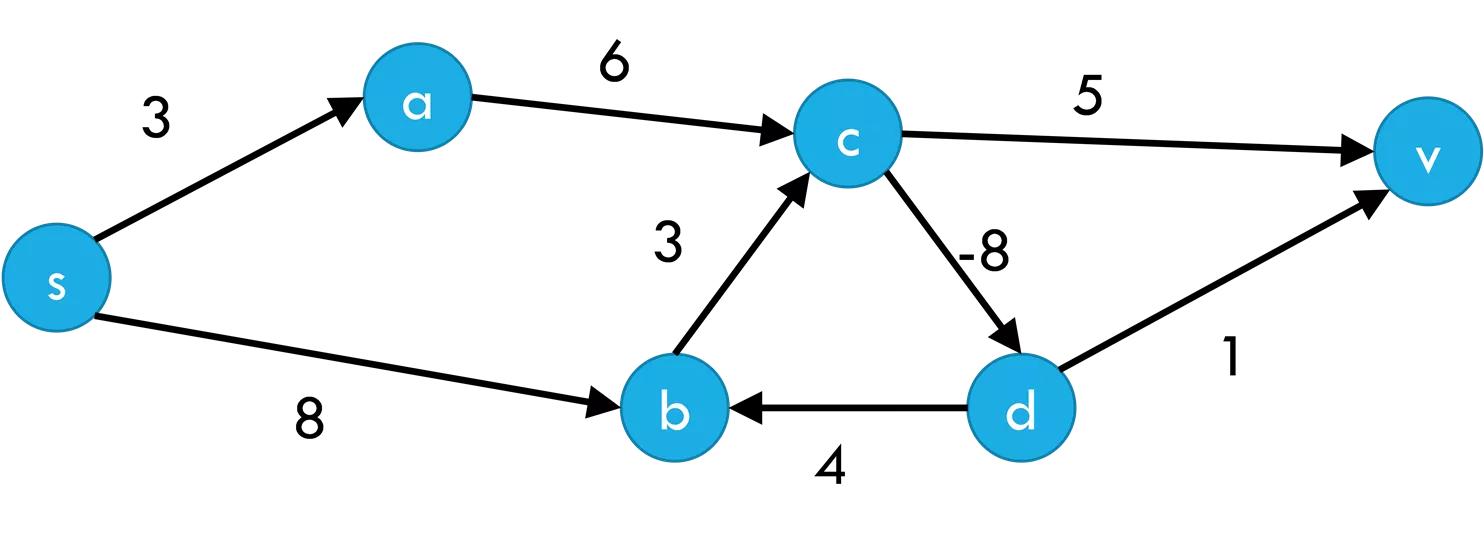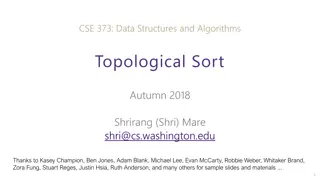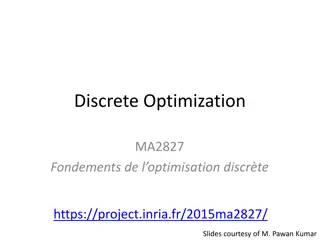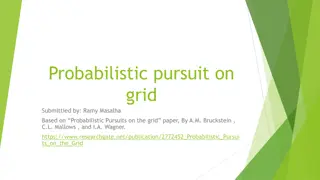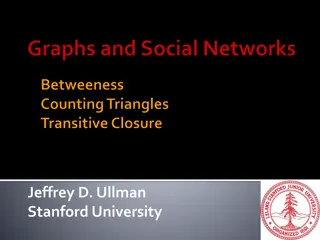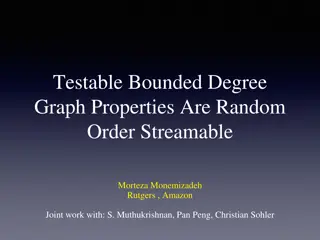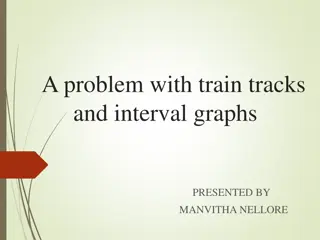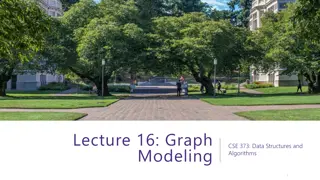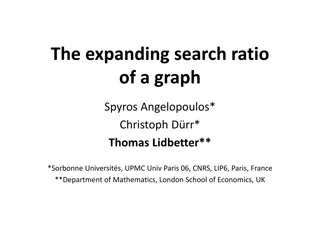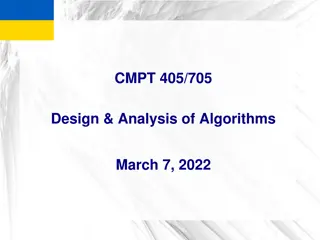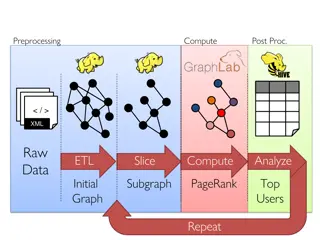Understanding All Pairs Shortest Paths Algorithms in Graph Theory
Learn about various algorithms such as Dijkstra's, Bellman-Ford, and more for finding the shortest paths between all pairs of vertices in a graph. Discover pre-computation benefits and clever recurrence relationships in optimizing path calculations.
Download Presentation

Please find below an Image/Link to download the presentation.
The content on the website is provided AS IS for your information and personal use only. It may not be sold, licensed, or shared on other websites without obtaining consent from the author. Download presentation by click this link. If you encounter any issues during the download, it is possible that the publisher has removed the file from their server.
E N D
Presentation Transcript
Linear Programming CSE 417 Winter 21 Lecture 16
Fill out the poll everywhere for Activity Credit! Go to pollev.com/cse417 and login with your UW identity Negative Cycle 6 5 a 3 c v 3 -8 s 1 b d 8 4 Vertex\? S A B C D V 0 0 1 0 3 8 2 0 3 8 9 3 0 3 8 9 1 14 4 0 3 5 9 1 2 5 6
Negative Cycles If you have a negative length edge: Dijkstra s might or might not give you the right answer. And it can t even tell you if there s a negative cycle (i.e. whether some of the answers are supposed to be negative infinity) For Bellman-Ford: Run one extra iteration of the main loop if any value changes, you have a negative length cycle. Some of the values you calculated are wrong. Run a BFS from the vertex that just changed. Anything you can find should have as the distance. (anything else has the correct [finite] value). If the extra iteration doesn t change values, no negative length cycle.
Laundry List of shortest pairs (so far) Algorithm BFS Running Time ?(? + ?) Special Case only Negative edges? ONLY unweighted graphs ONLY for DAGs X Simple DP Dijkstra s Bellman-Ford Yes! X Yes! ?(? + ?) ?(? + ?log?) ?(??)
All Pairs For Dijkstra s or Bellman-Ford we got the distances from the source to every vertex. What if we want the distances from every vertex to every other vertex? Why? Most commonly pre-computation. Imagine you re google maps you could run Dijkstra s every time anyone anywhere asks for directions Or store how to get between transit hubs and only use Dijkstra s locally.
Another Recurrence ???? ? = 0 if ? is the source min ?: ?,? ????? ? + ???? ? ?,? otherwise Another clever way to order paths. Put the vertices in some (arbitrary) order 1,2, ,? Let ????(?,?,?) be the distance from ? to ? where the only intermediate nodes are 1,2, ,? intermediate
????(?,?,?) 6 5 4 3 1 5 3 2 3 1 6 2 8 4 ???? 4,5,0 = ???? 4,5,1 = 11 ???? 4,5,2 = 9 ???? 4,5,6 = 9
Another Recurrence Put the vertices in some (arbitrary) order 1,2, ,? Let ????(?,?,?) be the distance from ? to ? where the only intermediate nodes are 1,2, ,? intermediate ???? ? ?,? 0 min dist ?,?,? 1 + dist ?,?,? 1 ,dist(?,?,? 1) otherwise if ? = 0,(?,?) exists if ? = 0,? = ? if ? = 0, no edge (?,?) dist ?,?,? =
Pseudocode dist[][] = new int[n-1][n-1] for(int i=0; i<n; i++) for(int j=0; j<n; j++) dist[i][j] = edge(i,j) ? weight(i,j) : for(int i=0; i<n; i++) dist[i][i] = 0 for every vertex ? for every vertex ? for every vertex ? if(dist[u][r] + dist[r][v] < dist[u][v]) dist[u][v]=dist[u][r] + dist[r][v] standard form of the Floyd-Warshall algorithm. Similar to Bellman-Ford, you can get rid of the last entry of the recurrence (only need 2D array, not 3D array).
Running Time ? ?3 How does that compare to Dijkstra s?
Running Time If you really want all-pairs Could run Dijkstra s ?times ?(?? + ?2log?) If ? ?2 then Floyd-Warshall matches! Floyd-Warshall also handles negative weight edges. If ???? ?,? < 0then you ve found a negative weight cycle.
Takeaways Some clever dynamic programming on graphs. Which library to use? Need just one source? Dijkstra s if no negative edge weights. Bellman-Ford if negative edges. Need all sources? Flord-Warshall if negative edges or ? ?2 Repeated Dijkstra s otherwise
Linear Programming Used WIDELY in business and operations research. Excel has a linear program solver. A very expressive expressive language for problem-solving Can represent a wide-variety of problems, including some we ve already seen. Deep, beautiful theory that we do not have time to cover.
Outline of rest of the week What is a linear program? A simple example LP Computational Issues An application Vertex Cover on trees (again) In a few weeks, we ll return to LPs as a method of approximating NP- hard problems.
Example Problem You re laying down soil for a bunch of new gardens. You got a few big piles of soil delivered (more than enough to cover the gardens) $1.5/unit 1.5 $2/unit 7 5 $4/unit $4/unit 10 $1.5/unit $3/unit $8/unit $2/unit 2.5 4 3 $4.5/unit
Example Problem What variables should we use? $1.5/unit 1.5 $2/unit 7 5 $4/unit $4/unit 10 $1.5/unit $3/unit $8/unit $2/unit 2.5 4 3 $4.5/unit
Example Problem What variables should we use? 3 One for each edge (how much to move from a pile to a garden) ??,3 $1.5/unit A 1.5 $2/unit C 7 5 $4/unit $4/unit 2 10 $1.5/unit $3/unit E.g. ??,3 is how many units moved from ? to 3. $8/unit 4 $2/unit 2.5 4 1 3 $4.5/unit B
Example Problem (??,1 3 + ??,2 4 + ??,3 1.5) + (??,1 2 + ??,2 1.5 + ??,4 4.5) + (??,2 4 + ??,3 2 + ??,4 8) What s the cost (in terms of the variables)? 3 ??,3 $1.5/unit A 1.5 Sum cost*var for all the variables $2/unit C 7 5 $4/unit $4/unit 2 10 $1.5/unit $3/unit $8/unit 4 $2/unit 2.5 4 1 3 $4.5/unit B
Example Problem What constraints are there on the variables? 3 ??,3 $1.5/unit A 1.5 $2/unit C 7 5 $4/unit $4/unit 2 10 $1.5/unit $3/unit $8/unit 4 $2/unit 2.5 4 1 3 $4.5/unit B
Example Problem Gardens each get enough soil: ??,1+ ??,1 4 ??,2+ ??,2+ ??,2 5 ??,3+ ??,3 1.5 ??,4+ ??,4 2.5 No anti-soil: ??,? 0 for all ?,? Can t overuse a pile: ??,1+ ??,2+ ??,3 7 ??,1+ ??,2+ ??,4 3 ??,2+ ??,3+ ??,4 10 What constraints are there on the variables? 3 ??,3 $1.5/unit A 1.5 $2/unit C 7 5 $4/unit $4/unit 2 10 $1.5/unit $3/unit $8/unit 4 $2/unit 2.5 4 1 3 $4.5/unit B
Full Definition Minimize: (??,1 3 + ??,2 4 + ??,3 1.5) + (??,1 2 + ??,2 1.5 + ??,4 4.5) + (??,2 4 + ??,3 2 + ??,4 8) Subject To: ??,1+ ??,1 4 ??,2+ ??,2+ ??,2 5 ??,3+ ??,3 1.5 ??,4+ ??,4 2.5 ??,1+ ??,2+ ??,3 7 ??,1+ ??,2+ ??,4 3 ??,2+ ??,3+ ??,4 10 ??,? 0 for all ?,?
A Linear Program A linear program is defined by: Real-valued variables Subject to a list of linear constraints variables linear constraints A linear constraint is a statement of the form: ???? ?? where ?? are constants, the ?? are variables and ?? is a constant. Maximizing or minimizing a linear objective function A linear objective function is a function of the form: ???? where ?? are constants and the ?? are variables.
Fill out the poll everywhere for Activity Credit! Go to pollev.com/cse417 and login with your UW identity Linear constraints Can you write each of these requirements as linear constraint(s)? Some of these are tricks ?? times ?? is at least 5 5?? is equal to 1 ?? 5 OR ?? 7 ?? is non-negative. ?? is an integer.
Fill out the poll everywhere for Activity Credit! Go to pollev.com/cse417 and login with your UW identity Linear constraints Can you write each of these requirements as linear constraint(s)? Some of these are tricks ?? times ?? is at least 5 5?? is equal to 1 ?? 5 OR ?? 7 ?? is non-negative. ?? is an integer.
What are we looking for? A solution (or point) is a setting of all the variables A feasible point feasible point is a point that satisfies all the constraints. An optimal point optimal point is a point that is feasible and has at least as good of an objective value as every other feasible point.
Example Problem Gardens each get enough soil: ??,1+ ??,1 4 ??,2+ ??,2+ ??,2 5 ??,3+ ??,3 1.5 ??,4+ ??,4 2.5 No anti-soil: ??,? 0 for all ?,? Can t overuse a pile: ??,1+ ??,2+ ??,3 7 ??,1+ ??,2+ ??,4 3 ??,2+ ??,3+ ??,4 10 3 1.5 $1.5/unit A 1.5 $2/unit A feasible point. Objective: 55 C 5 7 5 $4/unit $4/unit 2 10 $1.5/unit $3/unit 2.5 $8/unit 4 4 $2/unit 2.5 4 1 3 $4.5/unit B
Example Problem Gardens each get enough soil: ??,1+ ??,1 4 ??,2+ ??,2+ ??,2 5 ??,3+ ??,3 1.5 ??,4+ ??,4 2.5 No anti-soil: ??,? 0 for all ?,? Can t overuse a pile: ??,1+ ??,2+ ??,3 7 ??,1+ ??,2+ ??,4 3 ??,2+ ??,3+ ??,4 10 3 1.5 $1.5/unit A 1.5 $2/unit A feasible point. Objective: 44.25 C 7 5 $4/unit 4.5 $4/unit 2 10 0.5 This is an optimal point. There are others! $1.5/unit $3/unit $8/unit 4 4 2.5 $2/unit 2.5 4 1 3 $4.5/unit B
Another Question Change the problem Instead of infinitely divisible dirt What if instead we re moving whole unit things (the dirt is in bags we can t open or we re moving bikes or plants or anything else that can t be split) Well, the constraints will change (your demand and supplies will be integers)
Non-Integrality Some linear programs have optimal solutions that have some (or all) variables as non-integers (even with only integers in the objective function and constraints) . For dirt or water or anything arbitrarily divisible, no big deal! For cell phones or bicycles possibly a big deal! (also possibly not!)
What do you do if you need integers? Integer Programs Integer Programs are linear programs where you can mark some variables as needing to be integers. In practice often still solvable (Excel also has a solver for these problems). But no longer guaranteed to be efficient. And just rounding an LP answer often gets you really close. In theory lots of theory has been done for when the best answer will be an integer But sometimes there s just not a lot to be done
Solving LPs For this class, we re only going to think about library functions to solve linear programs (i.e. we won t teach you how any of the algorithms work) The most famous is the Simplex Method Simplex Method can be quite slow (exponential time) in the worst case. But rarely hits worst-case behavior. Very fast in practice. Idea: jump from extreme point to extreme point. The Ellipsoid Method Ellipsoid Method was the first theoretically polynomial time algorithm ?(?6) where ? is the number of bit needed to describe the LP (usually the number of constraints) Interior Point Methods Interior Point Methods are faster theoretically, and starting to catch up practically. ?(?2.373) theoretically
Extra Practice You have 20 pounds of gold and 40 pounds of silver. You can turn 2 pounds of silver and 3 pound of gold into a (really heavy) necklace that can be sold for $10. You can also turn 9 pounds of silver and 1 pound of gold into a (really fancy) shield that can be sold for $15. How many of each should you make to maximize your profit? (fractional values are ok for this problem
Extra Practice You have 20 pounds of gold and 40 pounds of silver. You can turn 2 pounds of silver and 3 pound of gold into a (really heavy) necklace that can be sold for $10. You can also turn 9 pounds of silver and 1 pound of gold into a (really fancy) shield that can be sold for $15. How many of each should you make to maximize your profit? Max 10? + 15? Subject to ? = 5.6 and ? = 3.2 (we ll give resources for solvers next lecture) Plugging into an LP solver would give 2? + 9? 40 3? + ? 20
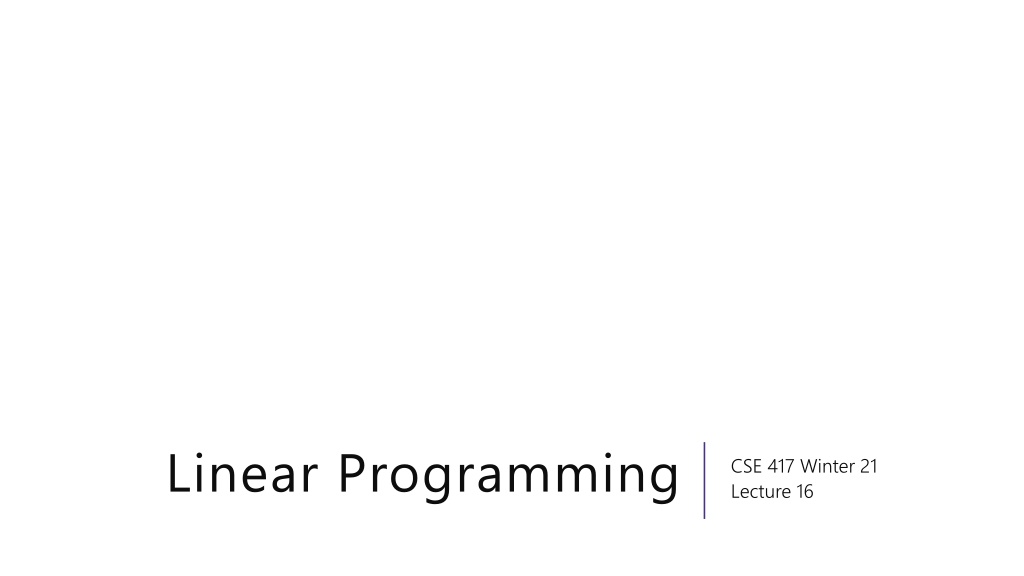
 undefined
undefined




